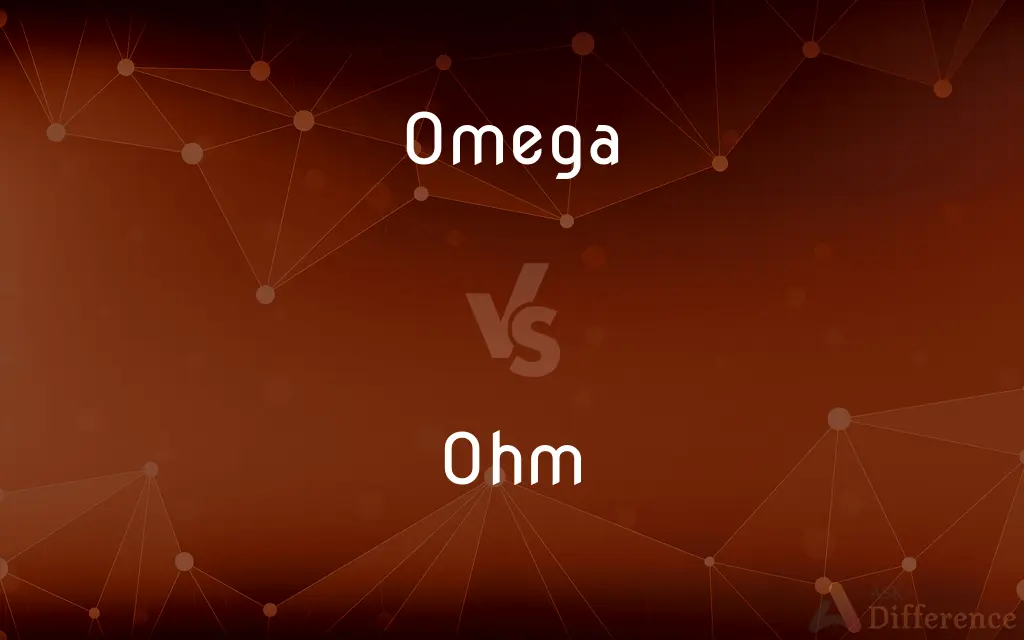Omega vs. Ohm — What's the Difference?
Edited by Tayyaba Rehman — By Urooj Arif — Updated on April 15, 2024
Omega symbolizes the end or last of a series, often used in Greek alphabets and cultural contexts, while Ohm represents electrical resistance unit, crucial in physics.

Difference Between Omega and Ohm
Table of Contents
ADVERTISEMENT
Key Differences
Omega is the last letter of the Greek alphabet, signifying completion or the end. In contrast, Ohm is a unit of electrical resistance named after the German physicist Georg Simon Ohm.
In various cultural and religious contexts, Omega is used metaphorically to denote the end or finality. On the other hand, Ohm is used scientifically to measure how difficult it is for electricity to flow through a conductor.
Omega often appears in a stylized form as a symbol in fraternal organizations and logos, highlighting its deep cultural resonance. Whereas Ohm is symbolized by an uppercase Greek letter omega (Ω), emphasizing its scientific and technical significance.
In literature and popular culture, "Alpha and Omega" represents the beginning and the end, illustrating Omega's symbolic versatility. Conversely, the Ohm symbol is ubiquitous in electronics and physics textbooks, denoting a specific measurable property.
Omega has also been adopted in various branding and design contexts to convey completeness and quality, such as in the name of the famous watch brand Omega. Meanwhile, Ohm remains a fundamental concept in physics and engineering education, essential for understanding electrical circuits.
ADVERTISEMENT
Comparison Chart
Definition
Last letter of the Greek alphabet
Unit of electrical resistance
Symbolism
End, completion
Electrical resistance
Cultural Use
Religious and cultural symbol
Limited to scientific contexts
Representative Symbol
Ω (Greek letter)
Ω (symbol for resistance)
Common Associations
"Alpha and Omega", completeness
Physics, electronics
Compare with Definitions
Omega
Used in cosmology to denote the density of the universe.
Scientists calculate Omega to understand the fate of the universe.
Ohm
Related to impedance in AC circuits.
The speaker's impedance is 8 Ohms.
Omega
A branding element to denote excellence and high quality.
The Omega watch is renowned for its craftsmanship.
Ohm
A unit measuring electrical resistance.
The resistor has a value of 5 Ohms.
Omega
Symbolizing the end or ultimate limit.
In the book, the character was described as the Omega of wisdom.
Ohm
Integral in calculating electrical currents.
They used Ohm's law to determine the current flow.
Omega
A final part in a series.
He considered himself the Omega of their group, always finishing their tasks.
Ohm
Symbolized by the Greek letter omega.
On the circuit diagram, each resistance was marked with an Ω.
Omega
The 24th letter of the Greek alphabet.
The fraternity logo incorporated the Omega symbol.
Ohm
Used metaphorically to discuss resistance or difficulty.
He referred to his challenging project as a '10 Ohm task.'
Omega
The 24th letter of the Greek alphabet. See Table at alphabet.
Ohm
The SI unit of electrical resistance, equal to the resistance of a conductor through which a current of one ampere flows given a one-volt potential across the conductor. See Table at measurement.
Omega
The last of a series; the end.
Ohm
The ohm (symbol: Ω) is the SI derived unit of electrical resistance, named after German physicist Georg Ohm. Various empirically derived standard units for electrical resistance were developed in connection with early telegraphy practice, and the British Association for the Advancement of Science proposed a unit derived from existing units of mass, length and time, and of a convenient scale for practical work as early as 1861.
Omega
In cosmology theory, the ratio of the average density of matter in the universe to its critical density.
Ohm
The SI unit of electrical resistance, transmitting a current of one ampere when subjected to a potential difference of one volt.
Omega
See omega baryon.
Ohm
In the International System of Units, the derived unit of electrical resistance; the electrical resistance of a device across which a potential difference of one volt causes a current of one ampere. Symbol: Ω
Omega
See omega meson.
Ohm
The standard unit in the measure of electrical resistance, being the resistance of a circuit in which a potential difference of one volt produces a current of one ampére. As defined by the International Electrical Congress in 1893, and by United States Statute, it is a resistance substantially equal to 109 units of resistance of the C. G. S. system of electro-magnetic units, and is represented by the resistance offered to an unvarying electric current by a column of mercury at the temperature of melting ice 14.4521 grams in mass, of a constant cross-sectional area, and of the length of 106.3 centimeters. As thus defined it is called the international ohm.
Omega
Relating to the end of the chain of carbon atoms that is opposite the carboxyl group in the molecule of a fatty acid.
Ohm
A unit of electrical resistance equal to the resistance between two points on a conductor when a potential difference of one volt between them produces a current of one ampere
Omega
The twenty-fourth letter of the Classical and the Modern Greek alphabet, and the twenty-eighth letter of the Old and the Ancient Greek alphabet, i.e. the last letter of every Greek alphabet. Uppercase version: Ω; lowercase: ω.
Ohm
German physicist who formulated Ohm's Law (1787-1854)
Omega
The end; the final, last or ultimate in a sequence.
Alpha and omega
Omega
(physics) Angular velocity; symbol: ω.
Omega
(set theory) A transfinite ordinal number referring to the next position after ordering a countably infinite set.
Omega
(slang) An omega male.
Omega
(finance) The percentage change in an option value divided by the percentage change in the underlying asset's price.
Omega
The last letter of the Greek alphabet. See Alpha.
Omega
The last; the end; hence, death.
"Omega! thou art Lord," they said.
The alpha and omega of science.
Omega
The ending of a series or sequence;
The Alpha and the Omega, the first and the last, the beginning and the end
Omega
The last (24th) letter of the Greek alphabet
Common Curiosities
Can Omega be used as a metaphor?
Yes, it is commonly used metaphorically to represent the end or ultimate point in discussions or literature.
What does the Ohm symbol represent?
It represents the unit of resistance in electrical systems.
What is the significance of Omega in the Greek alphabet?
Omega is the last letter, often symbolizing the end or completion.
Where does the term Omega come from?
It originates from the ancient Greek language, meaning "great O."
Does Omega have any scientific applications?
Besides cosmology, it is mainly used in symbolic and cultural contexts.
How is Ohm used in physics?
It is a unit of electrical resistance measuring the difficulty electricity has in flowing through a conductor.
Why is Ohm important in electronics?
Ohm helps in understanding and designing electrical circuits by quantifying resistance.
How does Omega relate to Alpha?
Alpha and Omega together are used to denote the beginning and the end, respectively.
Is there a physical representation of an Ohm?
Yes, it is typically represented by the Greek letter Ω on equipment and in diagrams.
How did Ohm get its name?
Named after Georg Simon Ohm, who formulated Ohm's Law in electrical science.
What role does Omega play in religious contexts?
It is often used to symbolize eternity or the end in Christian theology.
Share Your Discovery

Previous Comparison
Bag vs. Case
Next Comparison
Voucher vs. WarrantAuthor Spotlight
Written by
Urooj ArifUrooj is a skilled content writer at Ask Difference, known for her exceptional ability to simplify complex topics into engaging and informative content. With a passion for research and a flair for clear, concise writing, she consistently delivers articles that resonate with our diverse audience.
Edited by
Tayyaba RehmanTayyaba Rehman is a distinguished writer, currently serving as a primary contributor to askdifference.com. As a researcher in semantics and etymology, Tayyaba's passion for the complexity of languages and their distinctions has found a perfect home on the platform. Tayyaba delves into the intricacies of language, distinguishing between commonly confused words and phrases, thereby providing clarity for readers worldwide.














































